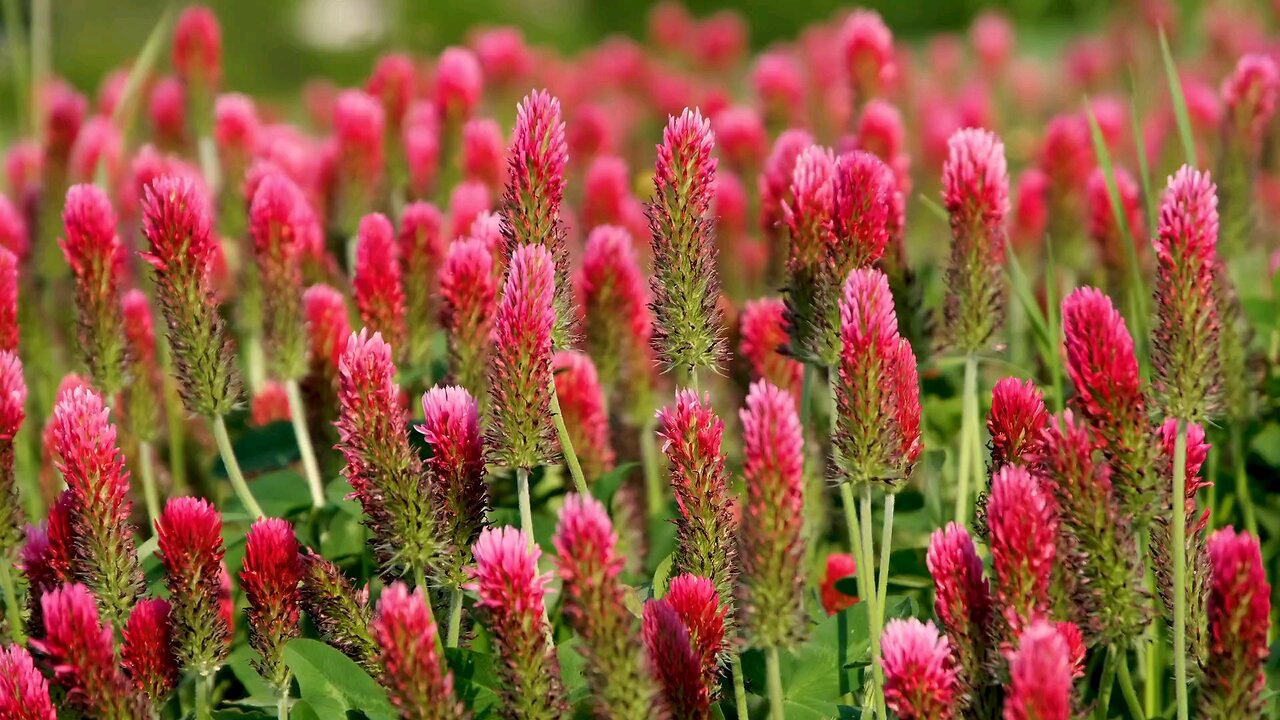Premium Only Content

"Red Clover (Trifolium pratense): Vibrant Blooms and Benefits"
Red clover (Trifolium pratense) is a perennial herbaceous plant belonging to the legume family (Fabaceae). It is native to Europe, Western Asia, and northwest Africa but has been widely naturalized in many other regions, including North America.
### Characteristics
- **Appearance**: Red clover has a characteristic pinkish-red flower head composed of numerous small, tubular florets. Its leaves are trifoliate, meaning they have three leaflets, often with a pale, crescent-shaped mark.
- **Growth**: It typically grows to a height of 20-80 cm and thrives in a variety of soils, especially well-drained, loamy soils. Red clover is often found in fields, meadows, and along roadsides.
- **Lifecycle**: It is a short-lived perennial, often surviving for 2-3 years.
### Uses
- **Agricultural**:
- **Forage Crop**: Widely used as livestock fodder due to its high protein content and palatability.
- **Cover Crop**: Helps in soil improvement and management, as it fixes nitrogen, improving soil fertility.
- **Crop Rotation**: Used in crop rotation systems to reduce soil erosion and improve soil structure.
- **Medicinal**: Red clover is known for its phytoestrogens, which are compounds that mimic estrogen in the body. It is used in traditional medicine for:
- **Menopausal Symptoms**: Alleviating hot flashes and other menopausal symptoms.
- **Skin Health**: Treating skin conditions like eczema and psoriasis.
- **Cardiovascular Health**: Supporting heart health by improving circulation and reducing blood pressure.
- **Culinary**: Though less common, the flowers and leaves can be used in salads or as a garnish. They are also sometimes used to make herbal teas.
### Environmental Benefits
- **Biodiversity**: Red clover provides a habitat and food source for various pollinators, including bees and butterflies.
- **Soil Health**: Enhances soil structure and fertility through nitrogen fixation and organic matter addition.
### Cultivation
- **Planting**: It is usually sown in early spring or late summer. It requires adequate sunlight and moderate watering.
- **Maintenance**: Minimal maintenance is required once established, but periodic mowing can encourage denser growth.
### Challenges
- **Pests and Diseases**: Susceptible to root rot, powdery mildew, and various pests like aphids.
- **Invasiveness**: While beneficial, it can sometimes become invasive in non-native regions, outcompeting local flora.
Overall, red clover is a versatile and valuable plant in agriculture, medicine, and environmental management.
-
 14:10
14:10
Dr. Nick Zyrowski
2 months agoThe AMAZING Health Benefits of NAC ( N-Acetyl Cysteine)
10.5K12 -
 5:14
5:14
Gamazda
1 month ago $3.73 earnedWhat Happens When You Mix Piano & Xylophone? Canon in D Like Magic!
12.4K33 -
 13:54
13:54
Mama to Five
14 hours ago $0.64 earnedWHAT I EAT IN A DAY! | FULL DAY OF MEALS AS A MOM OF 5
11.1K4 -
 1:01:18
1:01:18
Futures Edge: Finance Unfiltered with Jim Iuorio and Bob Iaccino
1 day ago $10.10 earnedLIVE Technical Analysis with Mike Arnold
60.9K2 -
 4:56
4:56
SLS - Street League Skateboarding
6 days agoDay in the Life of Pro Skateboarder Mariah Duran | Part 2
14.1K1 -
 14:32
14:32
Chubbyemu
2 days agoA Woman Drank 1 Liter Soy Sauce Colon Cleanse In 2 Hours. This Is What Happened To Her Brain.
25.9K12 -
 2:57:55
2:57:55
FreshandFit
5 hours agoAfter Hours w/ Girls
76.1K27 -
 22:23
22:23
Neil McCoy-Ward
15 hours agoThe Middle Class Just Collapsed...
17.9K7 -
 15:04
15:04
IsaacButterfield
23 hours ago $2.43 earnedThe Most Insane People My Algorithm Keeps Throwing at Me
15.1K4 -
 11:31
11:31
China Uncensored
16 hours agoTop 5 Countries That Sold Out to China
21.5K15